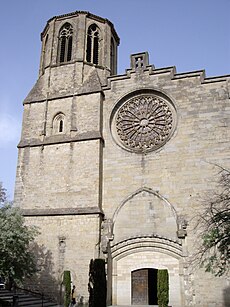Bishop of Carcassonne
|
Diocese of Carcassonne and Narbonne Dioecesis Carcassonensis et Narbonensis Diocèse de Carcassonne et Narbonne |
|
|---|---|

|
|
| Location | |
| Country | France |
| Ecclesiastical province | Montpellier |
| Metropolitan | Archdiocese of Montpellier |
| Statistics | |
| Area | 6,313 km2 (2,437 sq mi) |
| Population - Total - Catholics |
(as of 2013) 353,980 255,600 (72.2%) |
| Parishes | 14 |
| Information | |
| Denomination | Roman Catholic |
| Rite | Roman Rite |
| Established | 533 (established as Diocese of Carcassonne, renamed as Diocese of Carcassonne et Narbonne: 14 June 2006) |
| Cathedral | Cathedral of St Michael in Carcassonne |
| Patron saint |
St Nazarius and St Celsus St Michael the Archangel |
| Secular priests | 64 and 35 religious priests |
| Current leadership | |
| Pope | Francis |
| Bishop | Alain Planet |
| Metropolitan Archbishop | Pierre-Marie Carré |
| Emeritus Bishops | Jacques Joseph Marie Despierre (1982-2004) |
| Website | |
| Website of the Diocese | |
The Roman Catholic Diocese of Carcassonne, is a diocese of the Latin Rite of the Roman Catholic church in France. The diocese comprises the entire department of Aude. It is suffragan to the archdiocese of Montpellier.
On the occasion of the Concordat of 1802, the former Diocese of Carcassonne, nearly all the old Archdiocese of Narbonne, almost the entire Diocese of Saint-Papoul, a part of the ancient Diocese of Alet and ancient Diocese of Mirepoix, and the former Diocese of Perpignan, were united to make the one Diocese of Carcassone. In 1822 the Diocese of Perpignan was re-established. In 2006 the diocese was renamed the Diocese of Carcassonne and Narbonne.
Carcassonne was founded by the Visigoths during the Golden Age. The Visigoths sought to compensate themselves for the loss of Lodève and Uzès by having Carcassonne erected into a bishopric. The first of its bishops known to history was Sergius (589). Carcassonne already had an Archdeacon by the seventh century; Archdeacon Donnel subscribed at the 4th Council of Toledo in 633.
The churches of Nôtre-Dame de Canabès and Nôtre-Dame de Limoux, both of which date back to the ninth century, are still frequented by pilgrims. The Cathedral of Saints-Nazaire-et-Celse at Carcassonne was rebuilt toward the end of the eleventh century, the first work upon it being blessed by Pope Urban II, who had come to Carcassonne in 1088 to urge the Viscount Bernard Ato IV de Trincavel to join the Crusade. In 1295 Pope Urban addressed a letter to Bishop Pierre, confirming the institution of Clercs Regular of Saint Augustine in the Chapter of the Cathedral. The Chapter had existed for a considerable time, perhaps going back to Bishop Gimerius in the tenth century, but papal sanction confirmed and strengthened its position as a corporate body living under a Rule. The approvation of Urban II was confirmed by Pope Anastasius IV in 1154. The Chapter included as officers the two Archdeacons, two archpriests, a Sacristan, a Precentor, a Chamberlain, an Eleemosynary, and a master of the works. In 1439, the canons were secularized by Pope Eugenius IV, and the Chapter came to have as officers a Dean, the Archdeacon, a Precentor, and a Sacristan. There were thirty Canons, each with a prebend, and they received a new set of Statutes.
...
Wikipedia
